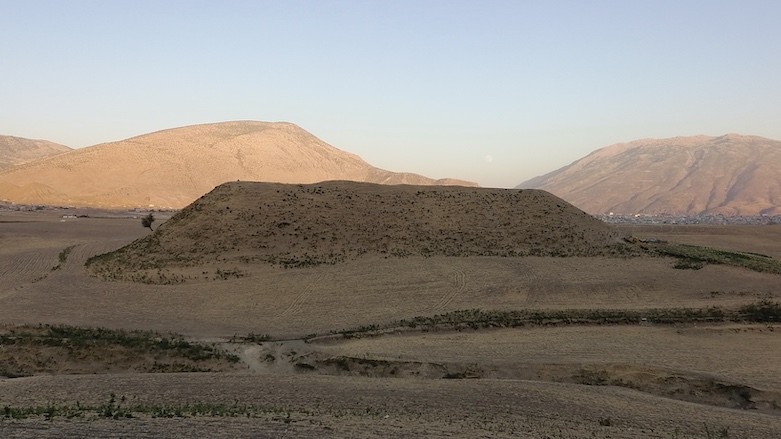Gird-i Dasht: The site of one of Kurdistan’s oldest settlements has stories to tell

Located in Delzyan’s vast plains, Gird-i Dasht is part of Soran’s identity. The structure is thousands of years old and its name literally means “the hill on the plain.”
Gird-i Dasht is an egg-shaped hill about 20 meters high. From afar it resembles Erbil’s iconic citadel, but little remains of the structure that used to be on top. There is only one road up the hill and it was intentionally damaged in the 1980s when it served as a military fortress.
The hill is a stunning attraction year-round and the villagers of Delzyan consider it evidence of the ancientness of their village. To them the hill, also called Glka-Dasht, is not only historically important but also a symbol of pride and part of their culture.

Sami Jawhar, who lives in Delzyan, told Kurdistan 24 that many of his childhood memories come from the hill. The 37-year-old said he remembered looking at the structure against the backdrop of the fertile lands surrounding the village. When he was young it was impossible to visit as Saddam’s army controlled the hill, but soon it was occupied by his own relatives in 1991 and he went many times.
Many of the other areas once under Saddam’s control also have historical value, like famous springs in Habasi-Khas and Kani-Sinj, and the hills of Sorabana and Girde-Kewa, he said.
Jawhar’s own family experienced tragedy at Gird-i Dasht when his 10-year-old brother was killed by weapons left in a former military base known as Qalaa right beside the hill.
Excavation
Gird-i Dasht is thought to be more than 7,000 years old and likely used by ancient Kurds, even before the Iron Age Urartu kingdom and far earlier than the conquest of the Assyrians.
The mound offers a strategic view of the surrounding plains, and one can easily see the mouth of the Gali Ali Bag waterfall, pathway to Rwandz, the peak of Hassan Bag, and Mergasor cave.
However, the people of Delzyan say the Soran Emirate in the 11th Century used the site as its capital before expanding further. Village elders told my father stories of ancient men who stood in long lines, passing river rocks from Blakyan-Hawdyan up the hill to build the citadel.

Abdulwahab Suleiman, the director of Soran’s Directory of Archeology, said researchers have concluded a castle once stood at the top of the hill during the reign of Mir Muhammad of the Soran Emirate (1826-1837).
Suleiman has concluded that the people who first settled the plains, ancient Kurds from Zagros mountain, were likely good farmers as the hill is located in the center of the district’s most fertile lands.
Due to its location near residential places and destruction by the Baath regime, some of Gird-i Dasht’s history is likely lost, Suleiman said. Archeologists have examined only about 5 percent of the data from two excavations, both of the site’s eastern side.
Two American-led teams from Boston University and the University of Pennsylvania led the excavations.

Excavations at the top of the hill in 2013 and 2014 were under the supervision of Dr. William Hafford (Penn Museum), Dr. John MacGinnis (Cambridge University), and assisted by Anashya Srinivasan and Danny Breegi (Boston University). They uncovered “a long sequence of successive fortifications consistent with the earlier interpretation that the site served as a fortress controlling the plain and access to one of the main outlets to the Rowanduz Gorge” and concluded it was continuously occupied from at least 2000 BCE to the early modern era, and still functioned until the Ottoman period starting in the 19th Century.
A low mound excavation was supervised by Dr. Richard Zettler and Katherine Burge of the University of Pennsylvania. The evidence showed early occupation in the Middle Bronze Age (from 2000 to 1600 BCE) based on ceramics uncovered at the site.

Faris Latif, a History Lecturer at Soran University who is from the area, told Kurdistan 24 that the site of Gird-i Dasht is one of the most rare and ancient sites in Kurdistan and the entire region.
Latif believes the hill may have been used 2,000 years before the Assyrian invasion of Kurdistan during the time of the Neo-Assyrian ruler Sargon II in the 8th Century, especially in his eighth campaign against the rival Uratu. Sargon’s forces are known to have traveled north through the Delzyan Plains to attack the kingdom of Musasir (1200-714 BC).
Suleiman said archeologists have uncovered samples, including pottery and other man-made items, more than 2 kilometers from Gird-i Dasht, suggesting the people who lived in the area had advanced knowledge of tools and craftwork. Some of the pottery dates back to the Bronze Age, about 8,000 years ago, and was created with high temperatures to resist breakage.
The director said Soran’s Directory of Archeology has agreed with the German Keele University to investigate what traces the ancient people of Delzyan have left in the Soran plains. The project, called “from the plains to the cave,” will seek to uncover the reasons the indigenous people of Kurdistan left early-modern villages and retreated to caves. The team will study Gird-i Dasht and the Shkawta Rash (“Black Cave”) in the mouth of the Gali Canyon.
Suleiman said they will investigate whether climate change, a famine, war, or another cataclysmic event forced people out of the plains and back into the mountains.
